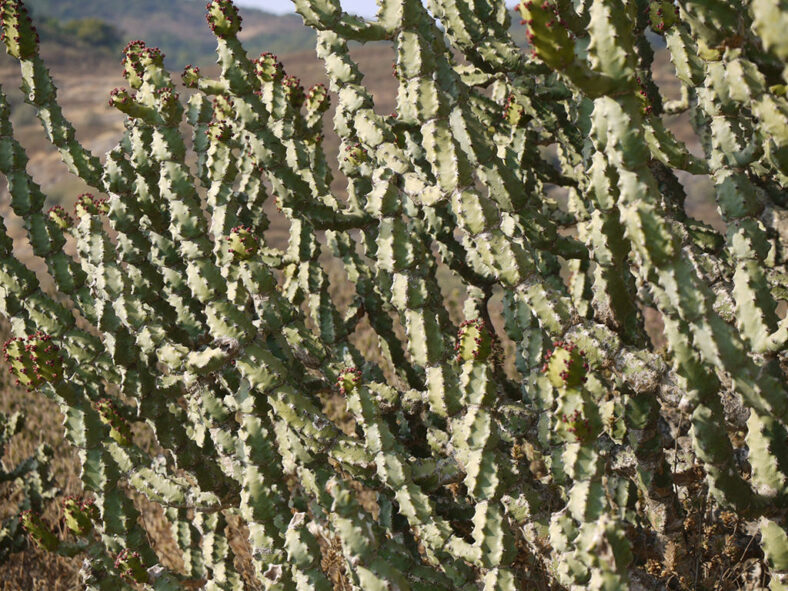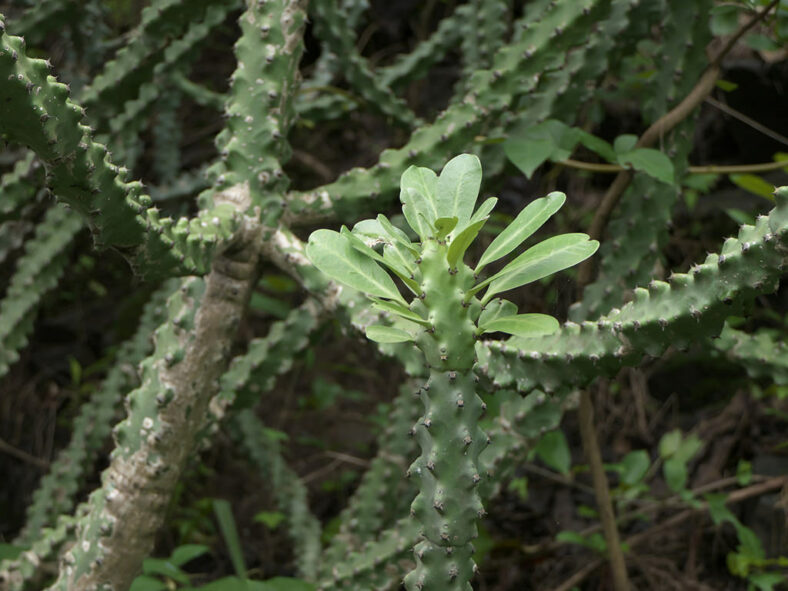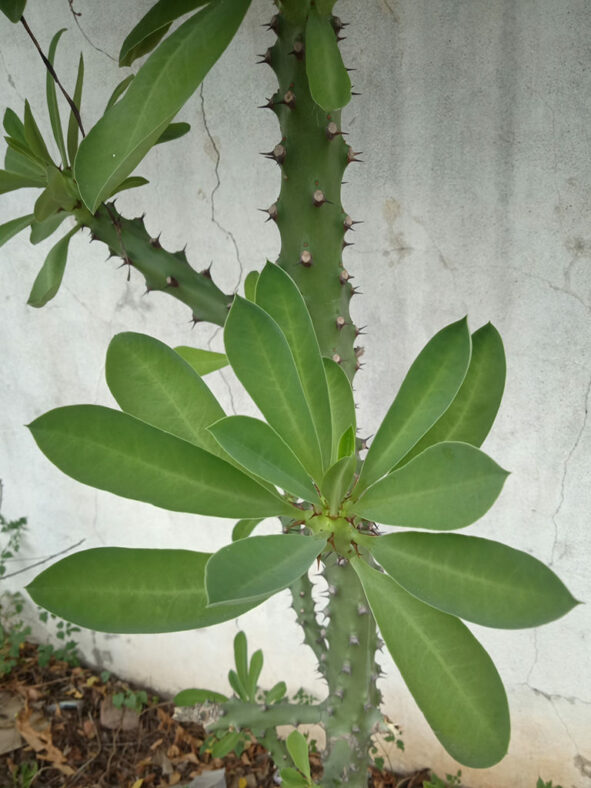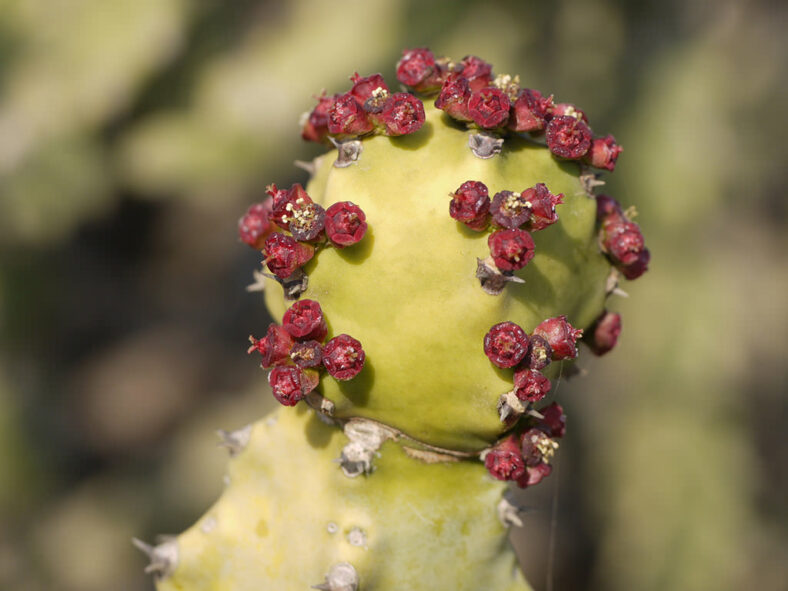Euphorbia neriifolia is often grown as an ornamental or hedge plant and is widely used in traditional medicine and as a source of food and materials in Asia and Central America.
Scientific Name
Euphorbia neriifolia L.
Common Name(s)
Common Milk Hedge, Dog's Tongue, Fleshy Spurge, Hedge Euphorbia, Holy Milk Hedge, Indian Spurge Tree, Leafed Euphorbia, Milk Bush, Milk Spurge, Oleander Spurge
Synonym(s)
Elaeophorbia neriifolia
Scientific Classification
Family: Euphorbiaceae
Subfamily: Euphorbioideae
Tribe: Euphorbieae
Subtribe: Euphorbiinae
Genus: Euphorbia
Etymology
The specific epithet "neriifolia (ner-ee-eye-FOH-lee-uh)" means "nerium-leafed, leaves like oleander" and refers to the resemblance of the leaves of this species to those of Nerium oleander.
Origin
Euphorbia neriifolia is native to the dry tropics of South India but widely cultivated in tropical Asia. It grows in dry thickets, woodlands, lowlands, and rocky grounds.
Description
Euphorbia neriifolia is an erect succulent shrub or small tree with a nearly cylindrical main stem and branches with five indistinct angles lined with spine shields, each with a pair of short spines. It can grow up to 13.1 feet (4 m) tall, and the main stem can reach up to 6 inches (15 cm) in diameter. The branches are ascending and branch from the upper parts. The leaves are obovate, usually present only at the tips of young branchlets, and can grow up to 7.2 inches (18 cm) long and 1.6 inches (4 cm) wide. The branchlets have five spiral ranks of tubercles tipped with a spine shield and a pair of short spines.
The plant flowers during the spring, and the reddish cyathia appear in groups of 3 in the axils of the upper leaves. The central one has no stalk, while the lateral ones have a peduncle up to 0.3 inches (0.7 cm) long. The fruits are 3-lobed capsules reaching up to 0.5 inches (1.2 cm) in diameter.

How to Grow and Care for Euphorbia neriifolia
Light: For optimal growth, Euphorbia neriifolia needs plenty of sunlight. During the warmer months, place it near a sunny window or move it to your balcony or garden, gradually increasing sun exposure to avoid sunburn.
Soil: Use a well-draining soil, either a commercial potting mix formulated for succulents or create your own well-draining soil.
Temperature: While high summer temperatures are not a problem, low winter temperatures can damage or kill your plant. Euphorbia neriifolia grows best in USDA Plant Hardiness Zones 10a to 11b, with average minimum winter temperatures ranging from 30 to 50 °F (-1.1 to 10 °C).
Watering: From spring to fall, water the plant when the soil's top inch (2.5 cm) feels dry. Reduce watering in winter and give it just enough water to prevent wilting. In the warm season, evening is the best time of the day for watering.
Fertilizing: To ensure the potted plant receives sufficient nutrients, apply a balanced fertilizer in a 10-10-10 NPK formulation, diluted to 1/4 strength weekly during the growing season.
Repotting: Although your Euphorbia neriifolia does not need to be repotted often, it will benefit from repotting when it outgrows its pot. The repotting is best done in early spring at the beginning of the growing season. Wear gloves, protective clothing, and appropriate eye protection when handling this plant.
Propagation: The easiest and quickest way to propagate this plant is by stem cuttings. Although it can be started from seeds, it can be difficult for them to germinate. Be sure to take cuttings only during the growing season; spring is the ideal time to sow seeds.
Learn more at How to Grow and Care for Euphorbia.
Toxicity of Euphorbia neriifolia
Euphorbia neriifolia produces a poisonous white milky sap that may cause burns or irritation if it comes into contact with the skin or eyes. Therefore, keeping this plant away from children and pets is best.
Links
- Back to genus Euphorbia
- Succupedia: Browse succulents by Scientific Name, Common Name, Genus, Family, USDA Hardiness Zone, Origin, or cacti by Genus
Photo Gallery
Click on a photo to see a larger version.



